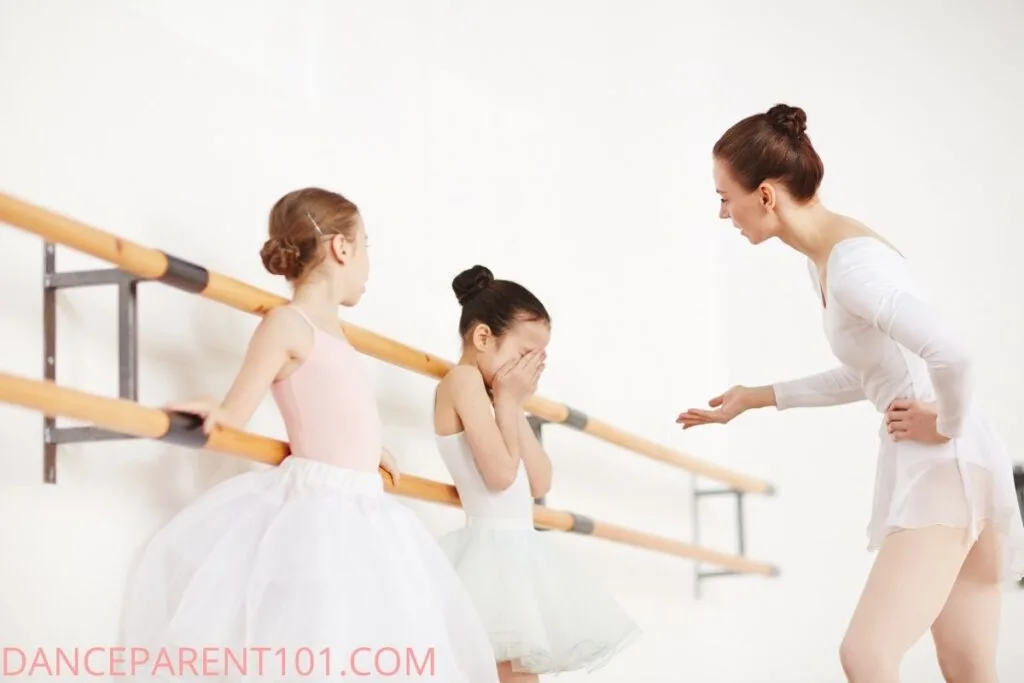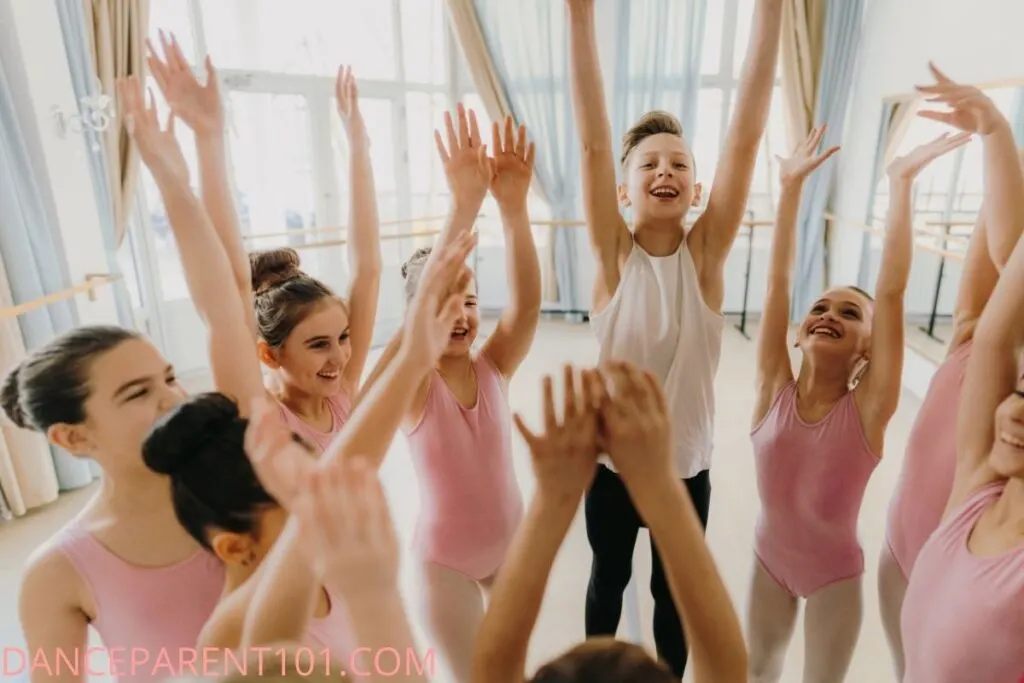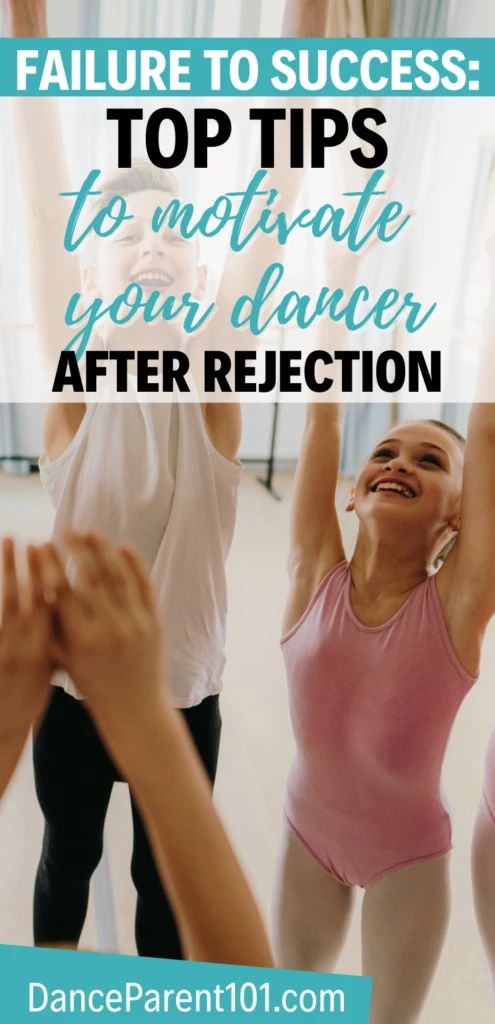By Heidi Williams / Edited by Samantha Bellerose, B.Ed, Dip.Dance(Performing Arts)
When I was a teenage dancer, I remember hearing the ancient Chinese proverb that says “failure is the mother of success,” and recognizing the wisdom in it, but also thinking that it was mostly a phrase people used to comfort others when they messed up big time.
Fast-forward to the present, after 20+ years as a dance educator and coach I have learned the importance and the value of failure.

As parents and teachers, it’s easy for us to understand this concept, because we have more life experience that has given us perspective. But what about younger dancers and students? Failure or rejection as a young dancer can feel so all-encompassing and life-altering. What are some ways we can help motivate our dancers after rejection?
We can motivate our dancers after rejections by changing the way we speak and think about failure, by removing the negative connotations associated with it.
We can help them reshape the way they see rejection in a dance setting so that they understand that failure isn’t just a series of potential setbacks within our efforts towards success, but it is literally part of what makes up the very fabric of success.
FOR DANCERS, FAILURE IS PART OF THE PROCESS; IT IS THE SCAFFOLDING OF SUCCESS.
When we fail, we learn – and not just learning in the way that we process information. We learn in a way that involves experience.
We gain empirical evidence.
Failure is a part of the experimentation process of learning. It’s the get-your-hands-dirty part of success. And because of this, it is a good thing. Even when it hurts, it is a good thing. Because the things we learn through failing are the things we will never ever forget.
HELPFUL THINGS TO REMIND YOUR DANCER OF ABOUT FAILURE…
DANCERS SHOULD NEVER COMPARE THEMSELVES TO OTHERS –ONLY TO THEIR PAST SELVES

Help young dancers to focus on progress rather than perfection. I always tell my competition students that there is always going to be someone out there who is better than them, no matter how good they get. That’s just life.
The world is filled with amazing dancers and talented people.
Assuming that you will get lucky and not encounter one at a competition simply isn’t realistic.
Also, if your limiting yourself by only aspiring to be as good as the potential competition you might be up against, that’s a failure of imagination, which ceilings your abilities and limits your potential.
Regardless of who we might compete against or audition against, comparing ourselves to them is a waste of time. All we can do is focus on being the best version of our dancing selves that we can possibly be.
And if we do that and still fail? Then we use that experience as a cheat code to refocus on moving forward and making progress. Failure is progress, so long as we learn from it.
“I may not be there yet, but I am closer than I was yesterday.” ― Misty Copeland
WHEN YOUR DANCER IS INCONSOLABLE TELL AN INSPIRING STORY ABOUT FAILURE

If your dancer is still on the teardrop train even after all efforts to console them, perhaps a story time is in order. Nothing like a little bit of history to drive home a solid slice of wisdom, and to remind them that many of the icons who are now household names had to stumble quite a bit before they flew.
FRED ASTAIRE
Fred Astaire is famously iconic among dancers and non-dancers alike –but he wasn’t always that way. “In his first screen test, the testing director of MGM noted that Astaire “Can’t act. Can’t sing. Slightly bald. Not handsome. Can dance a little.” Astaire went on to become an incredibly successful actor/singer/dancer and kept that note in his Beverly Hills home to remind him of where he came from” (Brainscape).
“The higher up you go, the more mistakes you are allowed. Right at the top, if you make enough of them, it’s considered to be your style.” – Fred Astaire
MISTY COPELAND
When it comes to dancers rebounding from rejection, perhaps there is no one more iconic in present times than Misty Copeland, who famously has had to overcome a lot in her dancing career — even after joining American Ballet Theatre.
As Misty divulged in an interview by CNN, “As an adult, I was told that I didn’t have the right skin color. I was too muscular. I was too curvy. My breasts were too big. I was too short.”
She had to endure not just the rejections, but also the prejudice that came from being a person of color in a historically white-dominated art form. Yet, despite all this, she continued to persevere.
She has since conquered her goals, and made history as the first African-American female principal dancer with the American Ballet Theatre.
“I knew that I just didn’t have it in me to give up, even if I sometimes felt like a fool for continuing to believe.”― Misty Copeland
DENZEL WASHINGTON, REGGIE JACKSON & TOMAS EDISON
Actor Denzel Washington reminded us of this in his famous commencement speech where he describes the necessity of failure as Falling Forward:
“Reggie Jackson struck out 2,600 times in his career, the most in the history of baseball, but you don’t hear about the strikeouts. People remember the home runs. Thomas Edison conducted 1000 failed experiments. Did you know that? I didn’t know that. Because the 1001st was the light bulb. Fall forward. Every failed experiment is one step closer to success. You’ve got to take risks” (Denzel Washington).
The pearl of truth in these examples? People don’t remember how many times you’ve failed; they remember that the sum of your failures was your success.
OTHER HELPFUL TIPS FOR DANCERS IN THE AFTERMATH OF REJECTION:
HELP THEM CULTIVATE RESILIENCE AS A DANCER
Keeping your dancer motivated after a setback can be challenging, especially if they’re still very much in their feelings about it.
However, they will build resilience through time, maturity, and experience. In an article by Dance Magazine clinical psychologist Joel Minden reminds dancers, “Pay attention to how you explain a rejection to yourself. Watch out for what psychologists call “the three P’s”: Does it feel personal, permanent or pervasive?”
He goes on to explain the importance of making sure dancers don’t take rejection personally, that they understand the experience is temporary, and isolated, and doesn’t reflect on every other area of dance.
Resilience as a dancer isn’t just important –it is necessary if they want to have a healthy experience in dancing throughout their lives, and if they want to have any type of longevity in their careers.
There will be more rejections than rewards for most of them, but the joy and the beauty of becoming a better dancer is in the journey and the process of trying to do just that. We do it for the love of it, not the shine from it.
LEARN FROM THE EXPERIENCE
Rejection, failure, and setbacks can be our best teachers and motivators, as long as we learn from the experience.
If it is possible, have your dancer ask for feedback from any adjudicators, teachers, etc who were there or involved.
Use the information given to hone in on areas that could be improved, and then set some SMART goals to conquer! This way, it’s less of a let-down for them, and they can retune their focus on the new challenge for improvement. Just like Bruce Lee said, “Research your own experience. Absorb what is useful, reject what is useless, add what is essentially your own.”
CULTIVATE GRATEFULNESS FROM FAILURE
Lastly, help your dancers to be just as thankful for rejection as they are for rewards or recognition.
Many kids these days are strangers to disappointment, especially when it comes to competition dance. Everyone gets an award, and nothing ever feels like a loss.
But disappointment is valuable because it generates growth.
We can use rejection and failure as tools to get us on the fast track to improvement because they force us to take a logical step back, adjust our expectations, and look at things from an objective standpoint.
What parts of my performance were great? What parts could be improved? What steps can I take to do better next time? What is my practice plan from here going forward?
FINAL THOUGHTS

A dancer’s life is full of ups and downs, both literally and figuratively.
One of the most helpful things we can do to prepare dancers for these inevitabilities is to remind them that whether they win or lose, the outcome is always in their favor if they use the experience to learn and grow from it.
A bboy/breakdance/breaker friend of mine often uses a phrase that I feel puts the fun into failure: “crash to create,” –meaning mistakes are just opportunities to create new moves.
Helping dancers revamp how they view failure or rejections, by turning obstacles into opportunities will have an undeniably transformative effect on them as a dancer and student.
The resilience they cultivate and nurture as a dancer will have a lasting impact on them as a person for the rest of their lives, not only in dance, but in all other aspects.
Embrace failure and rejection, seize the chance you’ve been given to challenge yourself.
“Decide what you want. Declare it to the world. See yourself winning. And remember that if you are persistent as well as patient, you can get whatever you seek.” ― Misty Copeland
Share this article on Pinterest Now!








